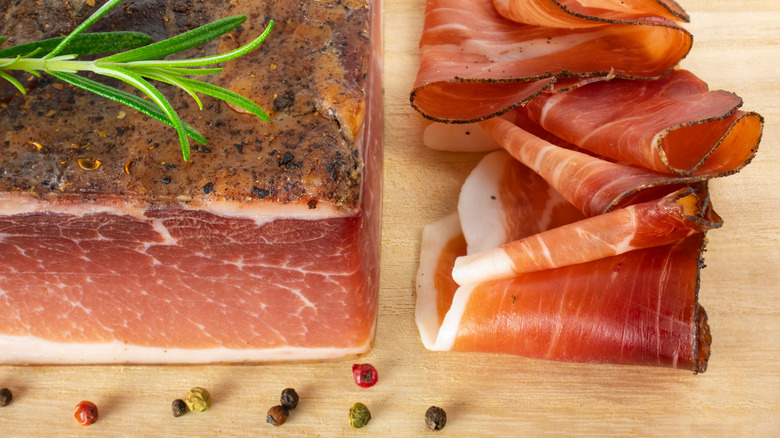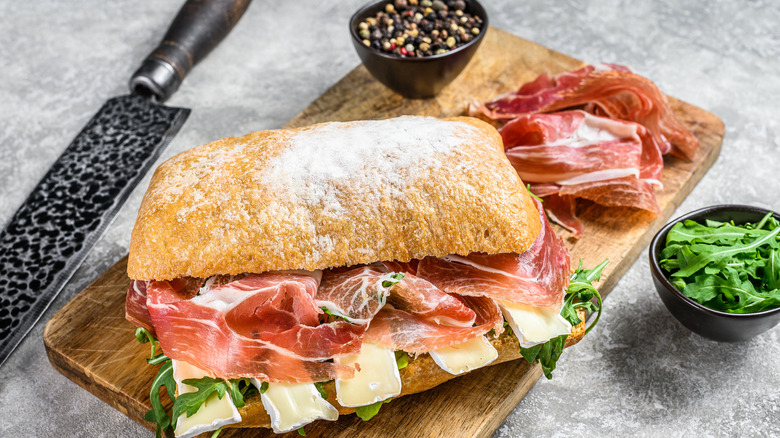What Is Prosciuttini And Is It The Same As The Beloved Prosciutto?
Is proscuittini just smaller prosciutto? Is prosciuttini made from young pigs instead of full-grown pigs? Is it just prosciutto with a cuter name? Multiple hams? No! Not quite. Proscuittini is peppered ham. Most often, this is ham that has been spiced with black pepper before and as it cures, similar to prosciutto, which is cured unflavored. Occasionally, prosciuttini will be sold uncured as oven-roasted ham coated with black pepper.
To make cured prosciuttini, a boneless, uncured ham traditionally from the pig's hind leg (a green ham) is dry cured with salt and sodium nitrates. This process draws the moisture out and makes the ham inhospitable to harmful bacteria. This is the same process that meats like pastrami and corned beef go through. Then it is massaged with salt again, coated in black pepper, and cured for another week. After this, it's left to dry in a humid environment for two to three months, then in a dry environment for up to three years. This process is the same as prosciutto — the only difference is the black pepper seasoning.
Why is there cooked and uncooked prosciuttini?
Prosciutto means "ham" in Italian. It's said the name evolved from the word "prosciugare," which translates to "to dry up or drain away." And certain types of prosciutto, Prosciutto di Parma, di Carpegna, di Modena, di Norcia, di San Daniele, Toscano, and Veneto Berico-Euganeo are all protected under DOP status: Denominazione di origine protetta (protected designation of origin). Each of these types of prosciutto meets very specific criteria pinned to a geographical location and technique for production. But the words prosciutto and prosciuttini are not protected. They don't carry regulations. They just mean "ham" and "little hams."
So some prosciutto is sold as something quite different from the hanging cured leg of ham you may be thinking of for your charcuterie board. Often, cooked ham is labeled "prosciutto cotto," but again, it's not required. If you don't pay attention, your prosciuttini may resemble a peppered, oven-roasted ham, deli sandwich ham, or ham pastrami rather than the rice-paper-thin shavings of cured meat you were expecting.
How to cook with and serve prosciuttini
Prosciuttini can be subbed in for prosciutto in any recipe that would benefit from black pepper. The pepper can be quite pungent, so it may overpower more delicate flavors like cantaloupe, but it would be excellent in wrapped asparagus appetizers. Taste your prosciuttini before committing to a recipe that would use prosciutto. If you couldn't add a good grinding of black pepper, you may want to skip it. However, a peppery persimmon, prosciutto, and pomegranate salad can hold up to the extra punch of prosciuttini.
Prosciuttini isn't just for charcuterie and hors d'oeuvres. It is an excellent addition to brunch (not to suggest that a charcuterie board cannot be brunch). Swap the prosciutto for its spicier cousin in a prosciutto parmesan quiche.
Just like pastrami, prosciuttini makes amazing sandwiches. It would give new life to grilled cheese, a jambon beurre, or a prosciutto lettuce tomato sandwich. It would cut through the richness and sweetness of a pickled fig and ricotta sandwich, adding a peppery bite to the saltiness of the prosciutto. Or, of course, you can shovel it into your mouth with a glass of wine and call it dinner.


